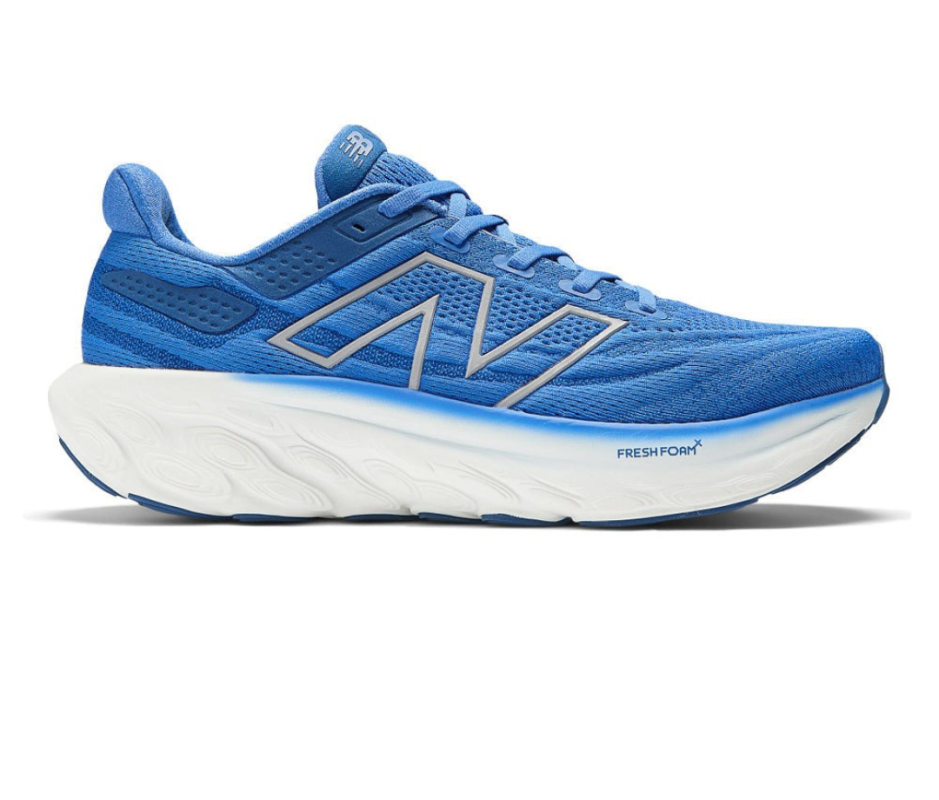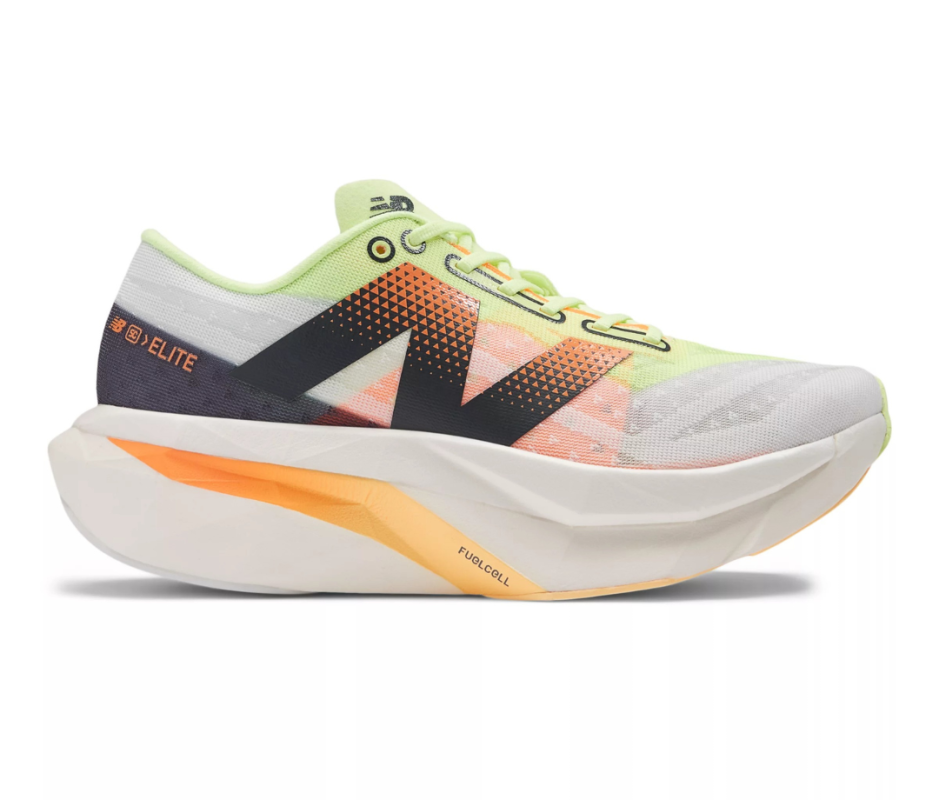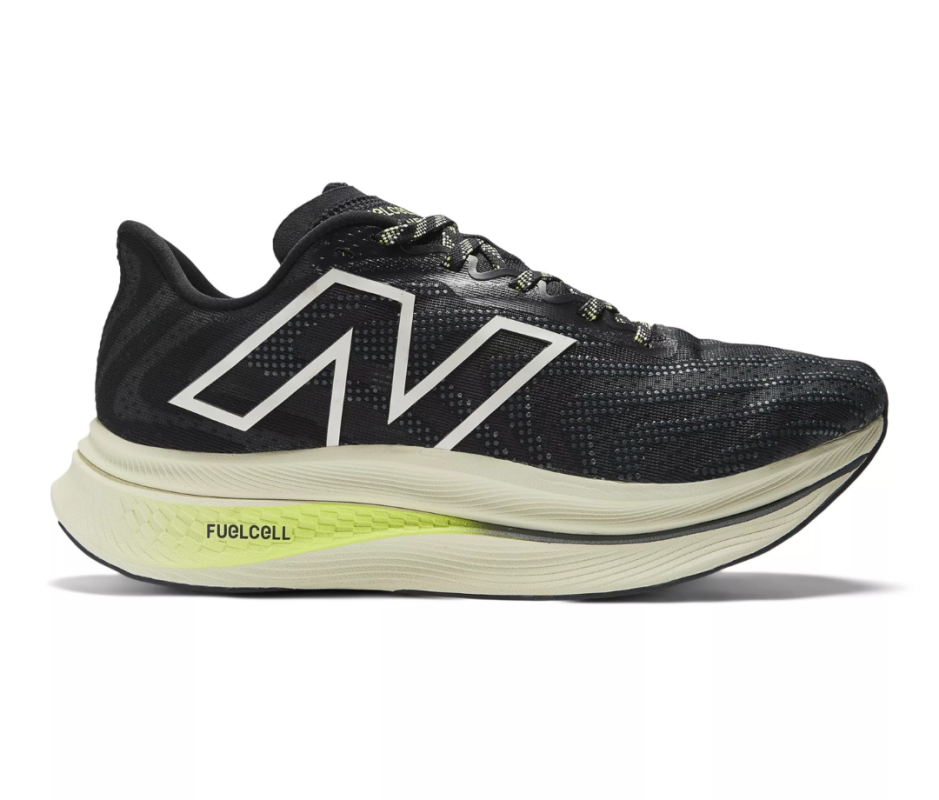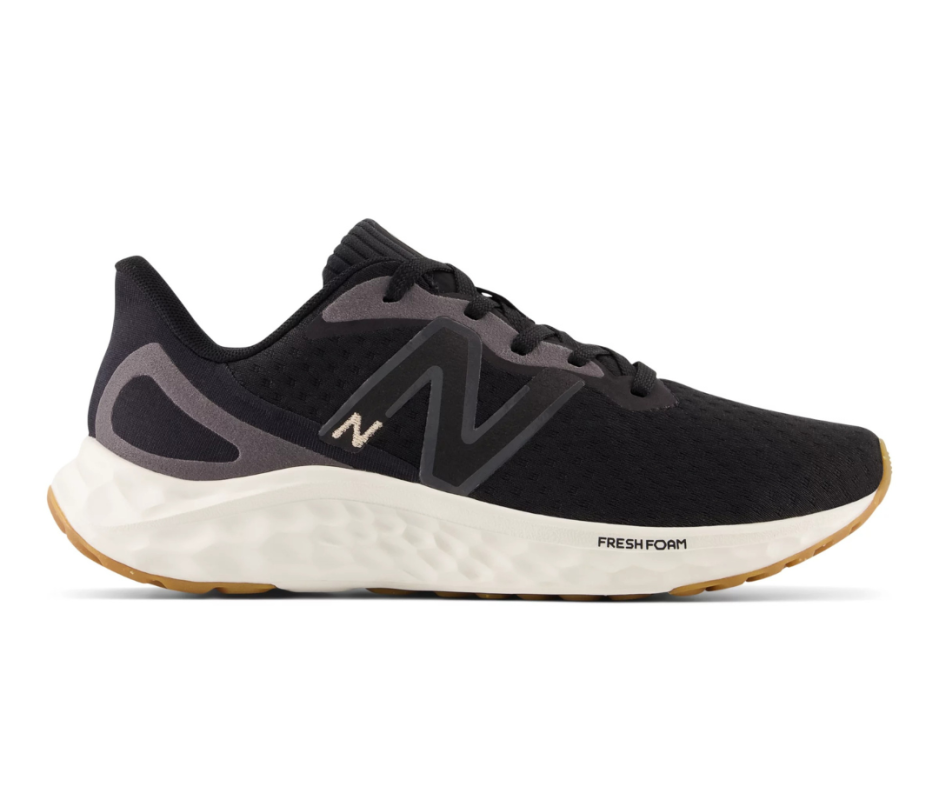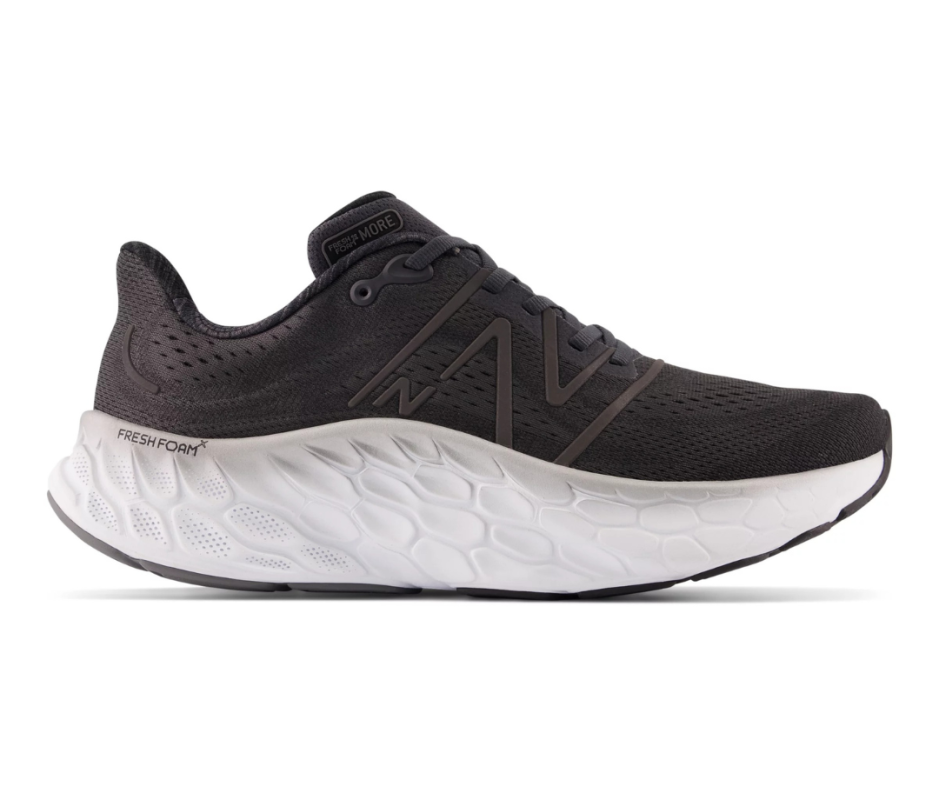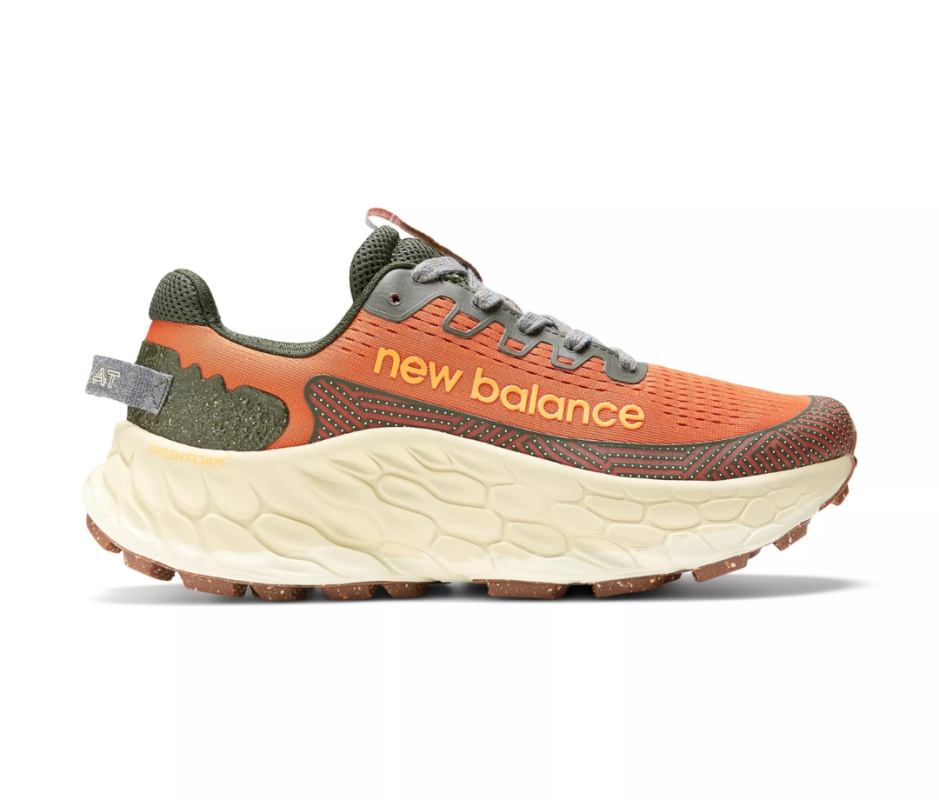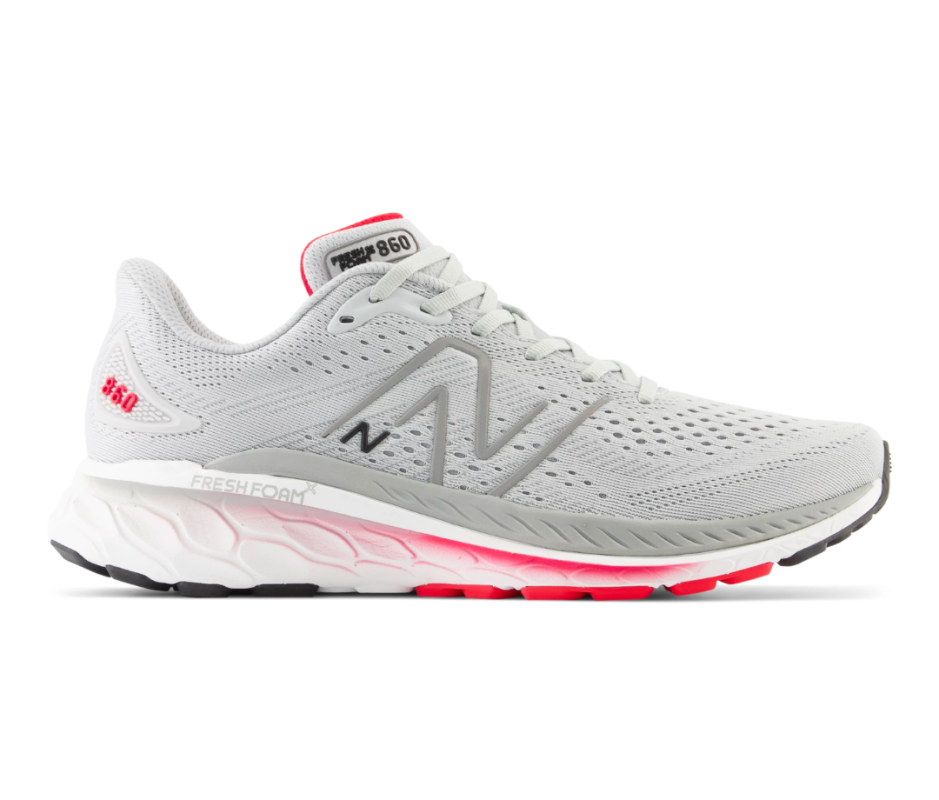Health
We Tested 16 New Balance Running Shoes. These Are the Best

Aside from churning out some of the best-looking running shoes on the market, New Balance innovates alongside heavy hitters like Nike and Adidas. It hasn’t shied away from implementing the latest tech, like ultra-light foams and carbon plates, while maintaining its heritage comfort and throwback vibe.
And what makes New Balance so widely appealing is the fact that it makes great shoes for every runner. Whether you are an elite marathoner or someone who jogs a few miles per week, the brand doesn’t feel exclusionary or niche. Its everyday trainers are versatile and durable—and its racers are comfortable, accessible, and lightning quick.
Men’s Journal aims to feature only the best products and services. If you buy something via one of our links, we may earn a commission.
Best Overall New Balance Running Shoe: FuelCell SuperComp Rebel v4
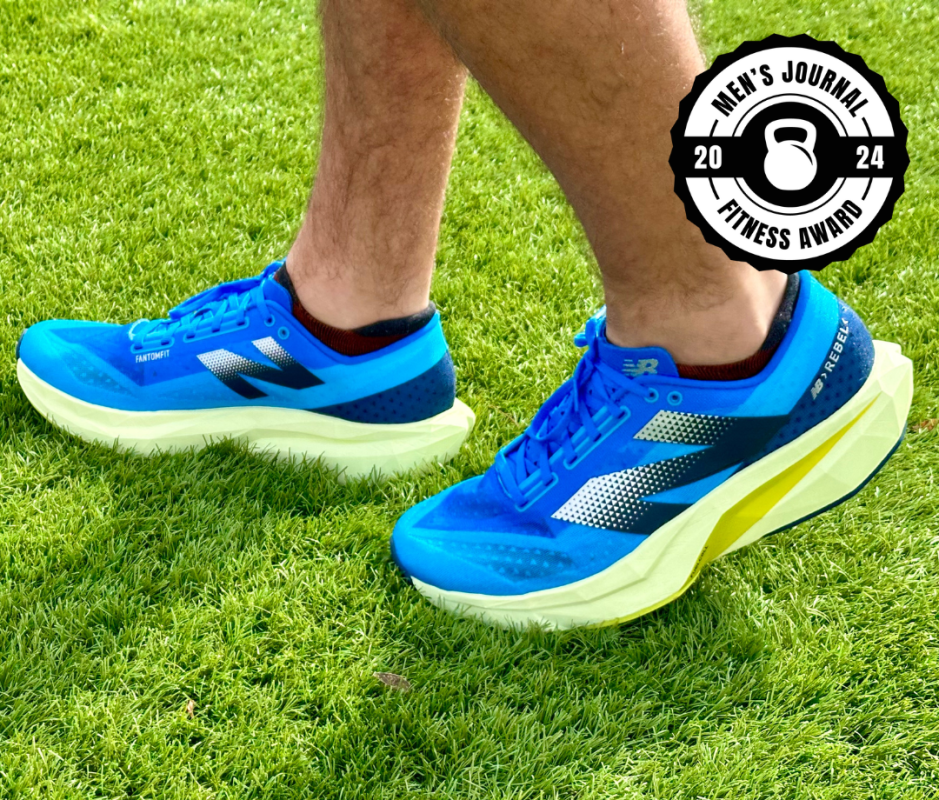
Nathan Lemin
The latest New Balance FuelCell SuperComp Rebel v4 is my early pick for best running shoe of the year. While previous versions of this shoe have varied in quality, the v4 nestles perfectly into the daily trainer category.
While some folks want niche offerings and multiple shoes for different efforts, I’m a big fan of versatility and value. That’s where the Rebel v4 shines. The shoe is peppy but not at the sacrifice of comfort. It’s nimble but doesn’t forgo stability. It’s fast and light but doesn’t cost a fortune. I took the Rebel v4 out on an easy 10K that ended with some interval speed work. I re-laced them once early on, then they stayed snug and felt great, even late in the effort. When I turned on the jets for some faster running, the extreme lightness of these shoes was really noticeable. Late into high intensity workouts, I notice things like energy return, smoothness of transition, and weight, and the Rebel v4 performed as hoped.
One of the shoe’s most direct competitors, the Asics NovaBlast 4, can’t quite match the pep or the lightness of the Rebel v4, and while I also love that shoe, I think this New Balance offering narrowly beats it. And for $140 this shoe offers more performance and more comfort than competitors. If you’re looking for a racing and training combo, the Rebel v4 and Elite v4 pair perfectly.
Pros:
- Capable and versatile for a great price.
- One of the lightest and most fun daily trainers I’ve tested.
- Updated PBA x EVA foam blend balances cushion, durability, and bounce.
- High stack height and sole width creates smooth, stable ride.
- Soft and comfortable FantomFit upper.
- Durable outsole rubber.
Cons:
- Foot slips out of shoe, despite gusseted tongue.
- Not the beefiest heel counter for a daily trainer.
Weight: 7.1 ounces (size 9)
Heel-Toe Drop: 6 mm
The New Balance Rebel v4 launches on March 1, 2024.
Best New Balance Running Shoe for Daily Training: Fresh Foam X 1080v13
Courtesy Image
The Men’s Journal test team has been loving the latest 1080 for nearly a year. New Balance claims if it only made a single shoe, this would be the one—and it’s not hard to see why. It packs a ton of versatility and performance into a sleek, lightweight package.
The 1080v13 utilizes New Balance’s latest Fresh Foam X, which our team found to be super soft underfoot. It excels as an everyday trainer, so if you can only buy one running shoe at a time, the 1080 is an excellent option.
The 1080v13 was one of my go-to shoes for easy miles, recovery runs, and threshold efforts. A member of our test team said it moved ahead of the SC Trainer v2 (mentioned below) as his favorite New Balance trainer.
Pros:
- Midsole, upper, and lacing all fit and feel great.
- Lightweight for the amount of cushion.
- Outsole performs well on wet terrain and light trails.
- Looks good
Cons:
- Not quite as responsive as the previous version.
- Plushness isn’t for everyone.
Weight: 9.2 ounces
Heel-Toe Drop: 6 mm
Best New Balance Marathon Racing Shoe: FuelCell SuperComp Elite v4
Courtesy Image
Just as exciting as the competition to break the marathon records is the race for the best super shoe among major companies. The team at New Balance had an excellent, accommodating racer in the FuelCell SuperComp Elite v3, but they elevated to a new level with v4.
The foam used for these shoes feels softer out of the box than competitors. There’s a meaningful squish in the Elite v4, and the bounce back is superb. Speeding up was effortless, but going slow feels good too. While other super-shoes cut weight at the expense of utility and comfort, the upper on this New Balance FC SC Elite v4 is really comfortable—although slightly warmer than competitors. I also love the fit, as the shoe didn’t take long to break-in.
The only issue I experienced with these shoes is that the tongue and laces loosened up over the course of my run. I retied them three times over a 10 mile run. Obviously that would be an issue in a race, but I plan to make this my racing shoe this year anyway. I was able to keep them snug using a tight surgeon’s knot at the top (looping your initial single knot an extra time or two), and if you had enough laces, a runner’s loop would likely work too.
Pros:
- More comfortable and approachable out of the box than other elite racing shoes
- Incredible energy return.
- Stable and tacky for a high-stack racing shoe.
Cons:
- Laces and tongue loosen while running, leading to some heel slippage.
- Soft outsole doesn’t seem very durable.
- Upper is a bit warmer than competitors.
Weight: 8.4 ounces
Heel-Toe Drop: 4 mm
More New Balance Running Shoes We Love
Best Long-Distance New Balance Running Shoe: FuelCell SuperComp Trainer v2
The SuperComp Trainer v2 was one of my favorite shoes last summer. They are peppy, comfortable, and look great. Whenever I had a Sunday long run or fartlek, these were one of my top choices. The combination of soft cushioning and propulsive plate felt comfortable and fast over big miles.
If you want to race in shoes that you can also frequently train in, give the SuperComp Trainer v2 a serious look. At $180 they are somewhat pricey for a trainer, but the ability to train speed and distance as well as race provides excellent value. Plus, for those not keen on carbon plates, the Trainer v2’s plate feels approachable and not as stiff as others. I also found the upper and laces to provide a secure fit.
Unfortunately for folks living on gravel roads, there is a large void in the center of the outsole that exposes the plate, and this gap picks up rocks, which then make a grating noise against the plate. Additionally, the outsole didn’t hold up as well as we would’ve liked, and I recommend keeping this on pretty smooth tarmac—avoid even light gravel. That said, the performance and comfort are excellent in the Trainer v2, and it is another great shoe in the FuelCell lineup.
Pros:
- Fun and fast.
- Comfortable.
- Versatile, can be used for training and racing.
- More stable than other long-distance trainers.
Cons:
- Outsole wears relatively fast.
- Exposed carbon plate void picks up rocks.
Weight: 9.7 ounces
Heel-Toe Drop: 6 mm
Best Budget New Balance Shoe: Fresh Foam Arishi v4
While there is nothing particularly inspiring about the Fresh Foam Arishi v4, for $70 you get a perfectly capable and solid looking shoe. It makes an excellent walking shoe or travel shoe, as the simple lines and lightweight comfort are solid for all-day wear.
However, I didn’t love running more than three miles in the Arishi. The laces don’t come up very high on the shoe, so I didn’t feel secure. However, I wore these all day around town for a weekend and like them for walking and as a pair of casual shoes, as they’re easy to slip on and off. While I wouldn’t recommend these to a serious runner, I do think they make a versatile pair of travel shoes, especially if you want to go on a couple runs when you’re on the go.
Pros:
- Affordable.
- Comfortable to walk in and run short distances.
- Lightweight.
- Durable, grippy outsole.
Cons:
- Poor lacing system doesn’t lock your foot in.
- Cushioning doesn’t hold up to longer distances
Weight: 9.5 ounces
Heel-Toe Drop: 6 mm
Best Max-Cushion New Balance Running Shoe: Fresh Foam X More v4
If you like soft cushioning, then the Fresh Foam X More v4 should be in your shoe rotation. I’ve never run in shoes as soft and squishy. That’s not for everyone, but for easy efforts, the considerable shock absorption make for a total comfort ride.
When you run, you exert a huge amount of force on your body. That isn’t always comfortable, especially if you’re heavier. A well-cushioned shoe that doesn’t feel clunky or heavy is hard to come by, so New Balance has made a compelling max cushion shoe with the latest FFX More v4.
Pros:
- Soft underfoot.
- Surprisingly lightweight.
- Super stable, great for heavier runners.
- Tacky and durable outsole.
Cons:
- Struggled to lock in fit with loose, stretchy material.
- Zaps energy return, especially on dead legs.
- Not versatile.
Weight: 8.4 ounces
Heel-Toe Drop: 4 mm
Best New Balance Trail Running Shoe: Fresh Foam X More Trail v3
A trail version of the Fresh Foam X More v4 featured above, the Fresh Foam X More Trail v3 is basically a road shoe with bigger lugs tacked on. I often opt for nimble, light trail runners that are pretty stiff because I value rock protection and quick feet when I’m running trails. The More Trail v3 is neither nimble nor stiff, but it provides excellent long-wearing comfort.
Over the course of testing, this became my go-to trail runner for easy miles. I used the More Trail v3 for runs with my dog, flowy single tracks, and other chill trail runs. While it’s not stiff and has no rock plate, the high amount of stack created a protective feel on trail. It felt a bit wide, even in the standard width, so it’s hard to lock in fit. And paired with the soft midsole, I occasionally experienced sloppy transitions going into turns and on uneven terrain. Therefore, this isn’t a shoe to run fast in, as the soft feel can slow momentum. Speaking of soft, the Vibram outsole lugs don’t provide full coverage of the midsole, so the exposed foam eventually gets chewed up on sharp rocks, diminishing long-term durability. That said, if you need a max cushion trail shoe, the New Balance Fresh Foam X More Trail v3 was surprisingly sweet.
Pros:
- Plush ride is ideal for long trail runs and recovery days.
- Flexible midsole and grippy Vibram lugs combine to create great traction.
- Available in three widths.
- Super stable on trail, especially less technical efforts.
Cons:
- Soft cushioning can slow momentum at times, especially uphill.
- Not very durable or nimble for a trail shoe.
- Slightly wide, even in standard width.
Weight: 11.4 ounces
Heel-Toe Drop: 4 mm
Best New Balance Stability Shoe: Fresh Foam X 860v13
These days, every running shoe company makes a great stability oriented shoe. New Balance provides overpronators support with their 860 lineup, and the Fresh Foam X 860v13 is a worthwhile iteration of that shoe.
While the More v4 and 1080v13 feel great, they both feature very soft cushioning. For certain runs, especially on varied terrain, I prefer a more solid platform. The 860v13 has a nice balance of stiffness and comfort; it still features the FreshFoam X that makes the 1080 so soft, but also includes some stiffer foam. It fits well right out of the box, with no need for creative lacing. The upper, while a little warm, provides lockdown fit and the stability features felt solid under the inner foot.
Pros:
- Added rigidity.
- Supportive medial post works as intended to prevent overpronation.
- Upper feels really snug and comfortable.
- Durable and tacky outsole, even on rougher surfaces.
Cons:
- Not particularly performance-driven.
Weight: 10.9 ounces
Heel-Toe Drop: 10 mm
Related: We Tested Every Hoka Running Shoe—These Are the Best
Why You Should Trust Me
I run in dozens of different running shoes every year. The shoes selected for this roundup by a team of testers and I are the culmination of months of testing. Some of the best New Balance running shoes have been on my feet since early last year, and many of these options are in my full-time, go-to running rotation.
Because I love New Balance so much as a running brand, I have particularly high expectations of its latest shoes and gear. I test all their shoes, especially newer versions of previously-tested models, with a close and critical eye. Their year-over-year improvement is part of why I admire the brand and their shoes as a whole.
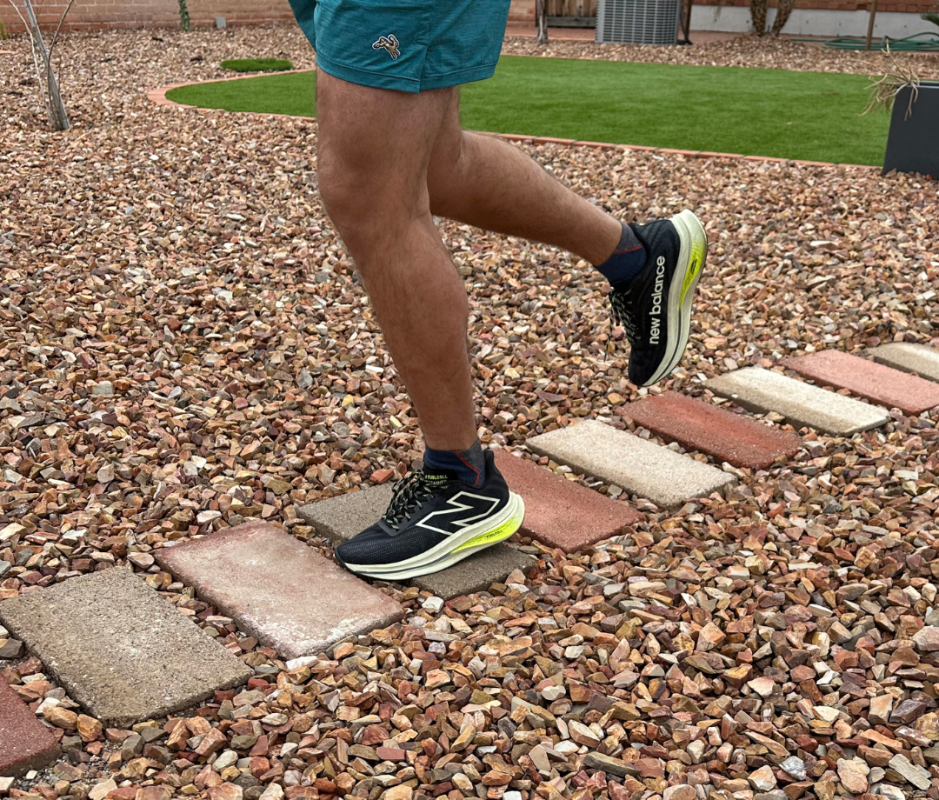
Nathan Lemin
What We Look for When Reviewing Running Shoes
My three go-to questions when testing running shoes are as follows:
- Do I want to wear it again?
- Is it holding up to frequent wear?
- Does it serve its intended purpose?
We here at Men’s Journal seek out durable, comfortable and capable running shoes that perform the job they were designed for. That means a racing shoe should provide speedier transitions, long-wearing comfort and lightweight fit, an everyday trainer should provide durable outsoles, accommodating fit and plenty of support, and a trail running shoe should provide excellent tread and enhanced protection.
In my training and racing efforts, New Balance shoes help me get the most out of my work. I find their shoes fit well, offering a range of widths in many models; they have a soft yet responsive cushioning, especially their FreshFoam X and FuelCell foams; and they look cool, too.
A few of the testers in our team have New Balance shoes in their regular rotation, including former cross-country and track athletes. On tester cited the balance of performance and comfort at a better price than other brands he used to train in. And it’s true, there are a couple shoes in this list that, at their price point, can’t be beat by any competitor.
Related: We Tested Dozens of On Running Shoes. These Are the Best
Health
The Hazards and Blessings of Being Male: Embracing the Seven Challenges For a Successful Life

Although there have been infinite varieties of life forms that have evolved on Earth in the last 4 billion years, two life forms that are our male and female ancestors evolved a billion years ago. Here’s how this first sexual experience occurred according to cosmologist Dr. Brian Swimme and historian Dr. Thomas Berry in their book, The Universe Story.
The first male organism—they call him Tristan—and the first female organism—they call her Iseult—began life in the ancient oceans. Swimme and Berry describe their chance encounter this way:
“They were cast into the marine adventure, with its traumas of starvation and of predation. Able to nourish themselves but no longer capable of dividing into daughter cells, such primal living beings made their way through life until an almost certain death ended their 3-billion-year lineage.
A slight, an ever so slight, chance existed that a Tristan cell would come upon a corresponding Iseult cell.They would brush against each other, a contact similar to so many trillions of other encounters in their oceanic adventure. But with this one, something new would awaken. Something unsuspected and powerful and intelligent, as if they had drunk a magical elixir, would enter the flow of electricity through each organism.
Suddenly the very chemistry of their cell membranes would begin to change. Interactions evoked by newly functioning segments of her DNA would restructure the molecular web of Iseult’s skin, so that an act she had never experienced or planned for would begin to take place—Tristan entering her cell wholly.”
Of course no humans were there to record this original encounter, but we all have origin stories and this one resonates with me. Dates are never exact and change as more information is gathered. Here are some additional dates I found important in The Universe Story timeline:
- 12 billion years ago, the universe begins.
- 4 billion years ago life first emerges.
- 1 billion years ago sexual reproduction evolves.
- 216 million years ago the first mammals appear.
- 30 million years ago the first apes inhabit the earth.
- 2.6 million years ago the first humans appeared.
- 200,000 years ago Archaic Homo sapiens evolved.
- 10,600 years ago first settlements in the Middle East emerged and wheat and barley were cultivated.
Needless to say, we have a long evolutionary history to embrace. In their book, Solving Modern Problems with a Stone-Age Brain, Douglas T. Kenrick, PhD and David E. Lundberg-Kenrick describe seven evolutionary challenges we must all face and embrace. They offer a visual summary as a revision of Maslow’s original Hierarchy of Human Needs which they call The New Pyramid of Human Motives:

The Seven Challenges for a Successful Life
During the billion years of life, all organisms must embrace these challenges and they are particularly relevant beginning with our mammalian history. In their book, the Kenricks ask, “What are the fundamental problems of human existence?” They go on to share the results of their research.
“Together with a large team of researchers at more than 30 universities on five continents, we have been investigating the universal motivations faced by human beings around the globe.”
Here is a summary of their findings:
We must meet our basic physiological needs for shelter from the elements,
water, and food.
- Protect yourself from attackers and plunderers.
Given the scarcity of resources and the ever-present possibility of starvation, there has always been competition among different groups (most often the male members) for precious real estate and resources (including access to females).
As the Kenricks remind us. “Our ancestors were not rugged individualists.
They need to band together not only to protect themselves from bands of
marauding bad guys but also to accomplish most of the tasks of everyday life.”
Some people have always been more resourceful and clever than others and
some were more willing to bravely defend their groups against armed marauders.
Those resourceful and courageous individuals won higher status and gained
greater respect.
“From the perspective of evolution by natural selection,” say the Kenricks, “this
step is essential. Every one of our ancestors managed to attract at least one
person who wanted to make with them. Not everybody in the ancient world got
to reproduce, though, and a reasonable percentage of men went unmated.” This
fact, is of major importance when understanding male desires, fears, and
behavior.
From an evolutionary perspective, we not only have to find a mate who will have
sex with us, but we need to hold on to our mate long enough to have a child and
raise the child to maturity, so they can find a mate and continue the process.
- Care for your family members.
Unlike other animals, human males are much more involved with raising children, since human children require long-term care before they reach reproductive age.
Males and Females Are Alike and Also Different
Males and females are alike in that they must both successfully meet the seven challenges noted above. However, there are also significant evolutionary differences. These differences first came home to me when I first met psychologist David M. Buss and read his book, The Evolution of Desire: Strategies of Human Mating.
“If mating desires and other features of human psychology are products of our evolutionary history,” says Dr. Buss, “they should be found universally, not just in the United States.”
To test his theories, he conducted a five-year study working with collaborators from thirty-seven cultures located on six continents and five islands. All major racial groups, religious groups, and ethnic groups were represented. In all, his research team surveyed 10,047 persons world-wide.
Dr. Buss concluded that there are actually two human natures, one male, the other female. What do women really want? Buss found that the top three qualities that women look for in men are exactly the same as those things that men look for in women: Intelligence, kindness, and love. Then, what women want diverges from what men want.
“Women then look at a man’s ability to protect her and her children, his capacity to provide, and his willingness to make commitment to a relationship,” says Buss.
What do men really want?
“A man is drawn to youth and beauty,”
says Buss.
“This interest is not just a modern desire driven by advertising and male desire to control women [though advertisers take advantage of our evolutionary-driven desires]. It is a universal desire based on evolutionary pressures for reproductive success. Men who mated with women who were incapable of bearing children left no ancestors. Every man alive today is descended from men who did not make that mistake. Worldwide, men are drawn to younger women.”
Note: Just because we have these evolutionary-based desires does not mean we must act on them, that they are good for us, or will make us, or the partners we desire, happy. It also does not mean they are hard-wired into our biological makeup and can’t be changed. It does mean that we must take seriously our evolutionary-based desires and listen to the ancient “whisperings within” that pull us in certain directions.
The Hazards and Blessings of Gender-Specific Health
The ancient Roman philosopher, Virgil offers a simple truth to consider.
“The greatest wealth is health.”
A modern American medical doctor, Marianne J. Legato, M.D., world-renowned cardiologist and founder of The Foundation For Gender-Specific Medicine, says,
“The premature death of men is the most important—and neglected—health issue of our time.”
Although human males, as a group, occupy more positions of power in government and business than women, it has come at a price. This was first brought home to me by psychologist Herb Goldberg, in his book 1976, The Hazards of Being Male.
“The male has paid a heavy price for his masculine ‘privilege’ and power. He is out of touch with his emotions and his body. He is playing by the rules of the male game plan and with lemming-like purpose he is destroying himself—emotionally, psychologically and physically.”
In recent years we have learned a lot more about the realities of being male.
“If it’s true that men rule the world, it comes at a heavy cost,”
says Dr. Legato.
“From conception until death, men are inherently more fragile and vulnerable than women. In virtually every society today, men die first.”
Dr. Legato offers the following facts of life:
- The male fetus is less likely to survive the womb than the female.
- Boys are six weeks behind in developmental maturity at birth compared to girls.
- Men have four times the developmental disabilities of females.
- Men suffer more severely than women from seven of the ten most common infections that human experience [Including Covid-19].
- Men are likely to experience the first ravages of coronary artery disease in their mid-thirties, a full 15 or 20 years before women.
- Twice as many men die of heart disease, the leading cause of all deaths, than do women.
- Men die by suicide 4 times more than women.
- Murder and homicide are among the top four killers of men from the time they are born until heart disease and cancers begin to claim those who survive into middle age.
Accepting the realities of our own inherent weakness and vulnerabilities instead of trying to pretend we are masters of the universe is the first step we just take to begin our own healing and recovery.
I have been writing a series of articles on the Future of Men’s Mental Health. In Part 3, “Gender-Specific Healing and Man Therapy,” I explore my own healing journey and issues that address the unique problems faced by men and how the emerging field of Gender-Specific Healing and Men’s Health is a key to the future of health care. If you’d like more information about upcoming trainings, drop me an email to Jed@MenAlive.com and put “Gender-Specific Health Training” in the subject line.
Health
Healthy No-Bake Peanut Butter Bliss Balls

This post may contain affiliate links. As an Amazon Associate, I earn from qualifying purchases. Please read my disclosure.
My no-bake, healthy peanut butter bliss balls are loaded with creamy peanut butter and chocolate flavor, making them a hit with both kids and adults alike. Enjoy these as an on-the-go breakfast, wholesome snack, or healthy dessert alternative! They’re also dairy-free, vegan, gluten-free, and low in sugar, making them ideal for a variety of dietary preferences.
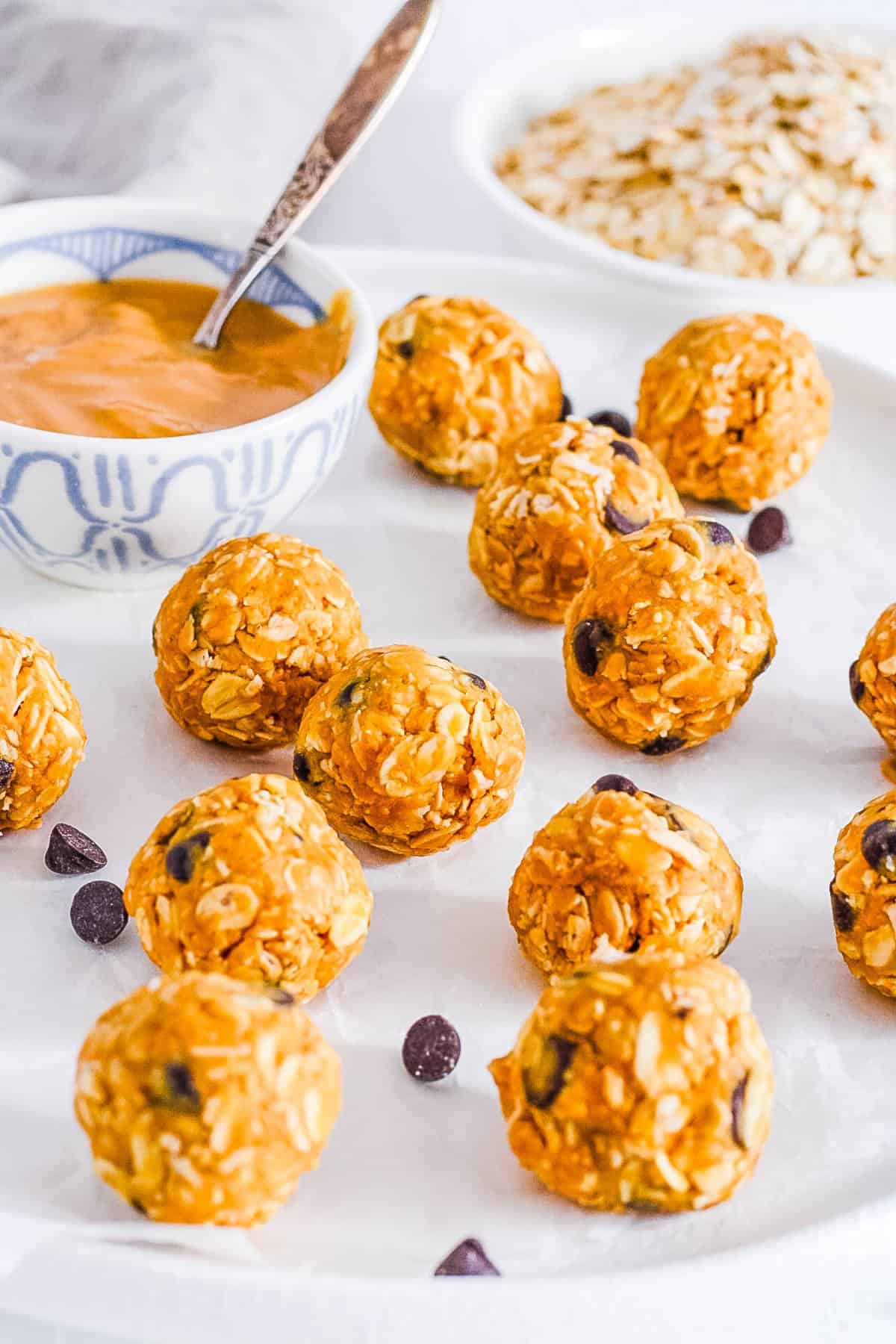
Indulge in my delicious no-bake peanut butter bliss balls, affectionately called “cookie dough bites” by my daughter. They taste like dessert, but are totally guilt-free and nutrient-rich! I love bliss ball recipes like this one because they come together quickly, and always satisfy my sweet tooth!
With only five simple ingredients and just ten minutes of prep time, bliss balls are a perfect option for busy days. I especially love making a huge batch at the beginning of the week, and enjoying them all week long for ultimate convenience. I find that they taste even better the next day, once they’ve had time to chill in the fridge for a while longer!
These protein balls with peanut butter are such a fun treat for any time of day! I really love how versatile they are – I’ll often use them as part of a quick breakfast, for packing in my kids’ lunches, or as a mid-afternoon snack.
Made with natural peanut butter, hearty oats, and a touch of pure maple syrup, I’ve crafted these bliss balls to be as healthy as possible. You won’t find any refined sugar here, even with these healthy swaps they still taste just like cookie dough. And each ball has only 90 calories and 3 grams of sugar!
I’ve also made sure that these wholesome ingredients can come together with minimal equipment required. No need to deal with your bulky food processor and spend all that extra time cleaning!
And my all time favorite thing about this recipe is that it’s a great way to involve kids in the kitchen. My kids have so much fun helping me out and adding in their own special twists.
Your family can also customize them in so many different ways, changing things up based on your preferences! I’ll share my favorite variations later in this post (like my peanut butter bliss balls with protein powder)!
Latest Recipe Video!
🥘 Ingredients
My easy peanut butter bliss balls recipe calls for just 5 nutritious ingredients, all easily found in your pantry or local grocery store. Here’s what you need:
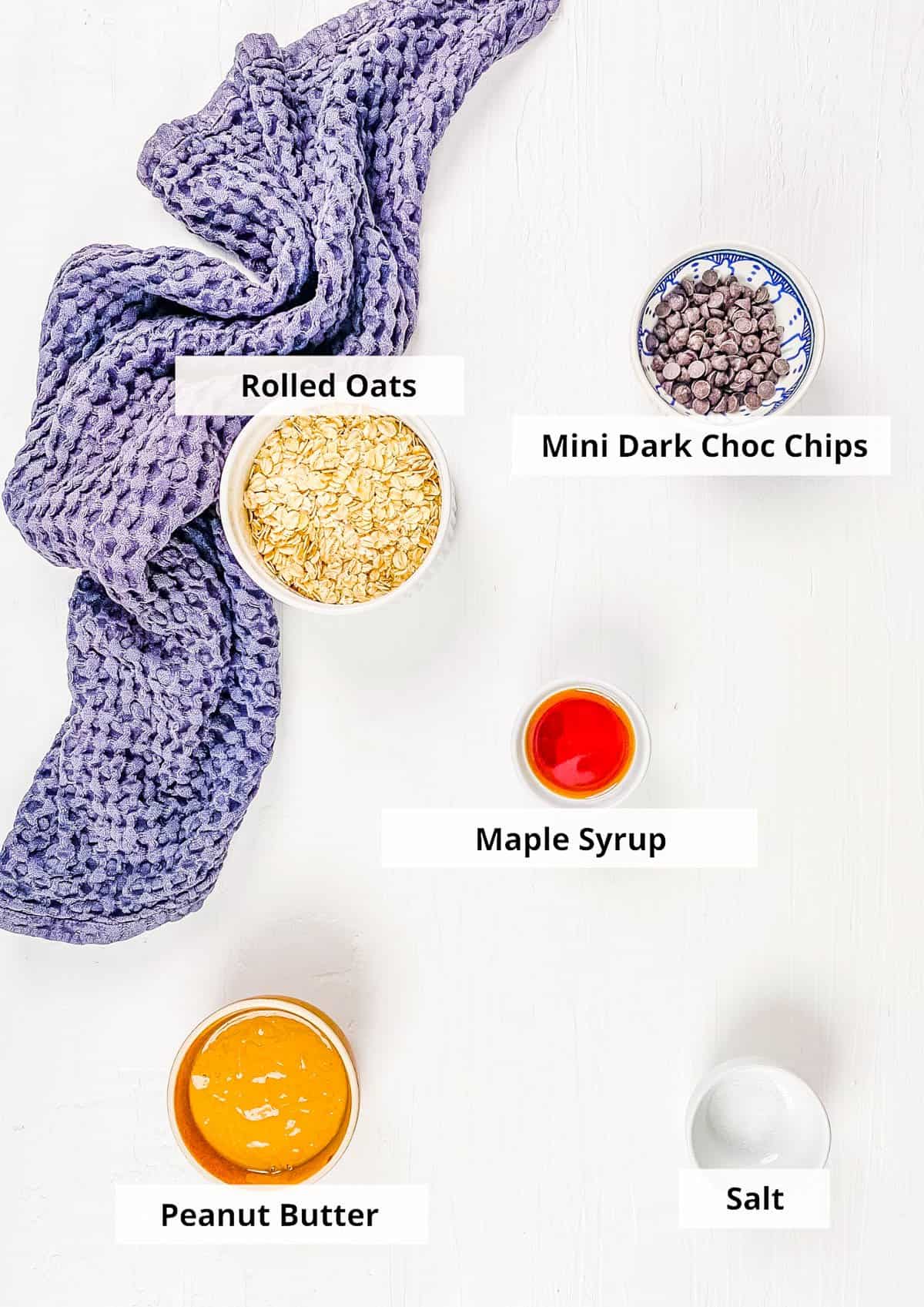
Oats: I’ve found that rolled oats work best for these kid-friendly bliss balls. I don’t recommend using oat flour or quick oats as it won’t have the same texture as whole oats, and won’t hold up as well.
Natural Peanut Butter: I use creamy peanut butter to bind all the ingredients together and add a boost of protein to these energy bites. If you don’t have peanut butter, try almond butter as a 1:1 substitute. Other nut butters (like cashew butter or a mixed nut butter) should also work in place of peanut butter, but the bites might have a slightly different consistency since some nuts create a thinner or runnier butter than others!
Dark Chocolate Chips: I prefer using dark chocolate chips for a healthier choice. These can be regular or mini chocolate chips. To keep this recipe vegan-friendly, I’ll use dairy-free chocolate chips. If you don’t need these to be vegan, then semisweet, white chocolate, or milk chocolate chips are all yummy options.
Maple Syrup: The only added sugar is natural maple syrup which gives the bliss balls a slightly sweet taste. If you don’t have maple syrup on hand, agave, raw honey, or vegan honey work.
Vanilla Extract: Pure vanilla extract brings out the richness of the chocolate. Sometimes I also add a pinch of salt to really enhance the sweetness. For a nutty flavor, try using almond extract.
🔪 How To Make Peanut Butter Bliss Balls
My vegan no bake peanut butter balls are so easy to make – they’re ready in just 3 simple steps. Let me show you how to make these healthy dessert balls:
Combine Ingredients: In a large bowl, using a wooden spoon, I start by stirring together the oats, peanut butter, chocolate chips, maple syrup, vanilla, and salt until combined.
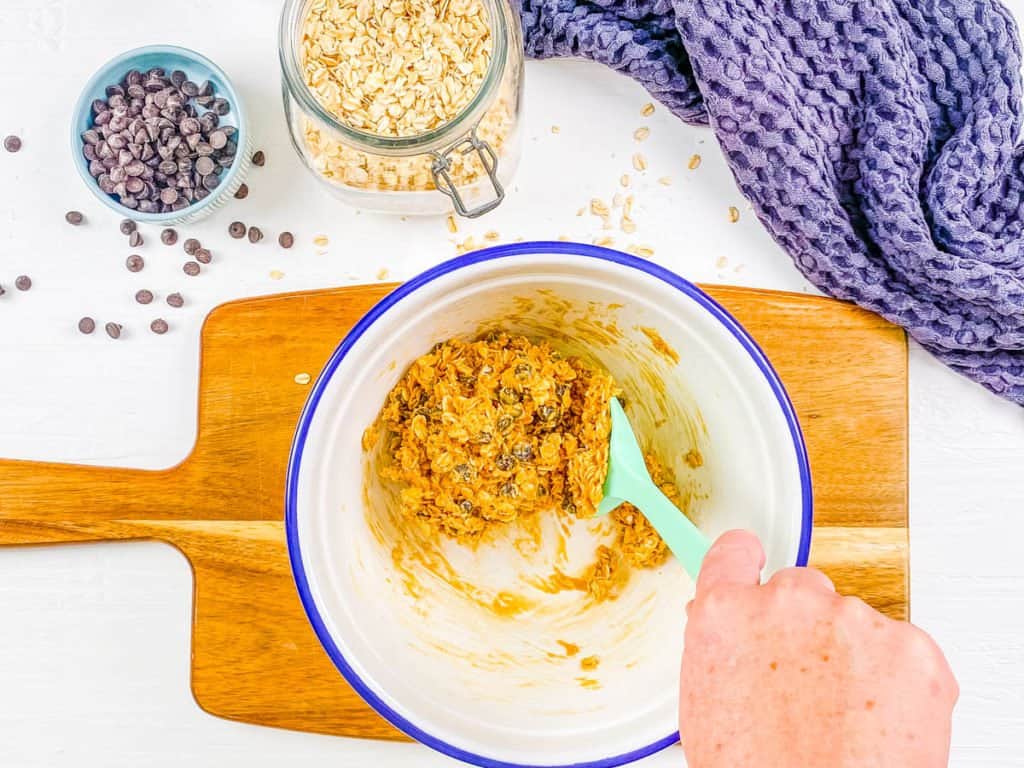
Form The Bliss Balls: Next, I line a baking sheet with parchment paper. Taking small handfuls of the mixture, I roll them into small balls 1-2 inches in size – about the size of a golf ball or ping pong ball. I prefer to use a cookie scoop to make this step extra easy. Place each ball onto the baking sheet.
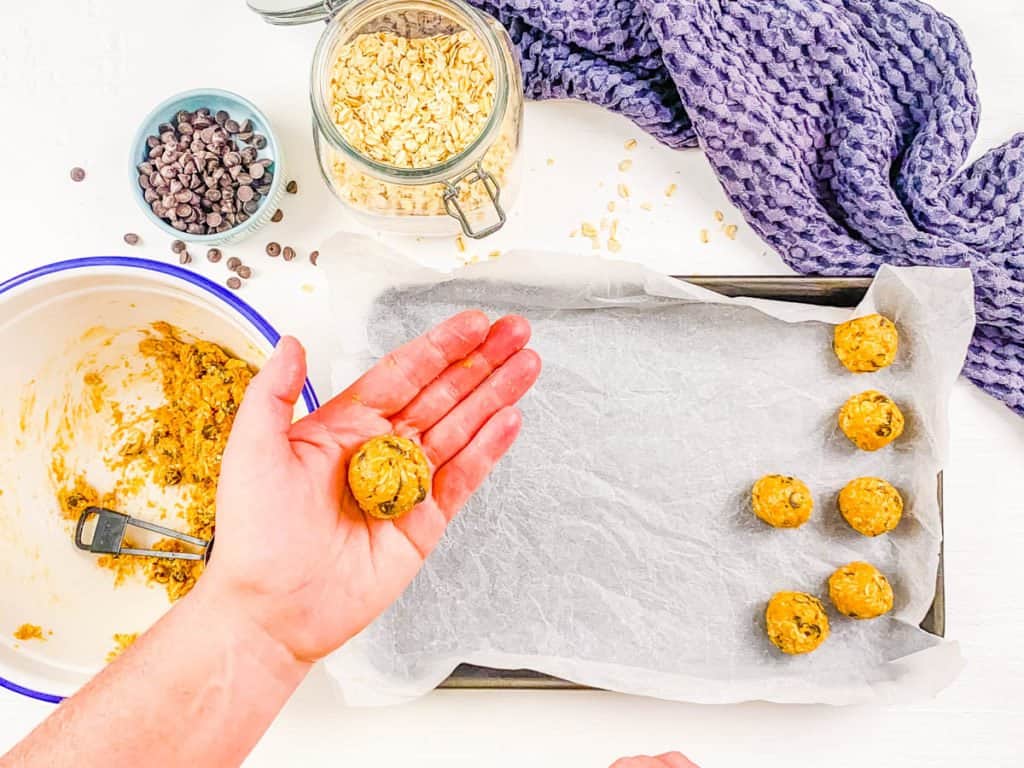
Let The Balls Set: Once rolled, I refrigerate these peanut butter snack balls for 30 minutes or until solid.
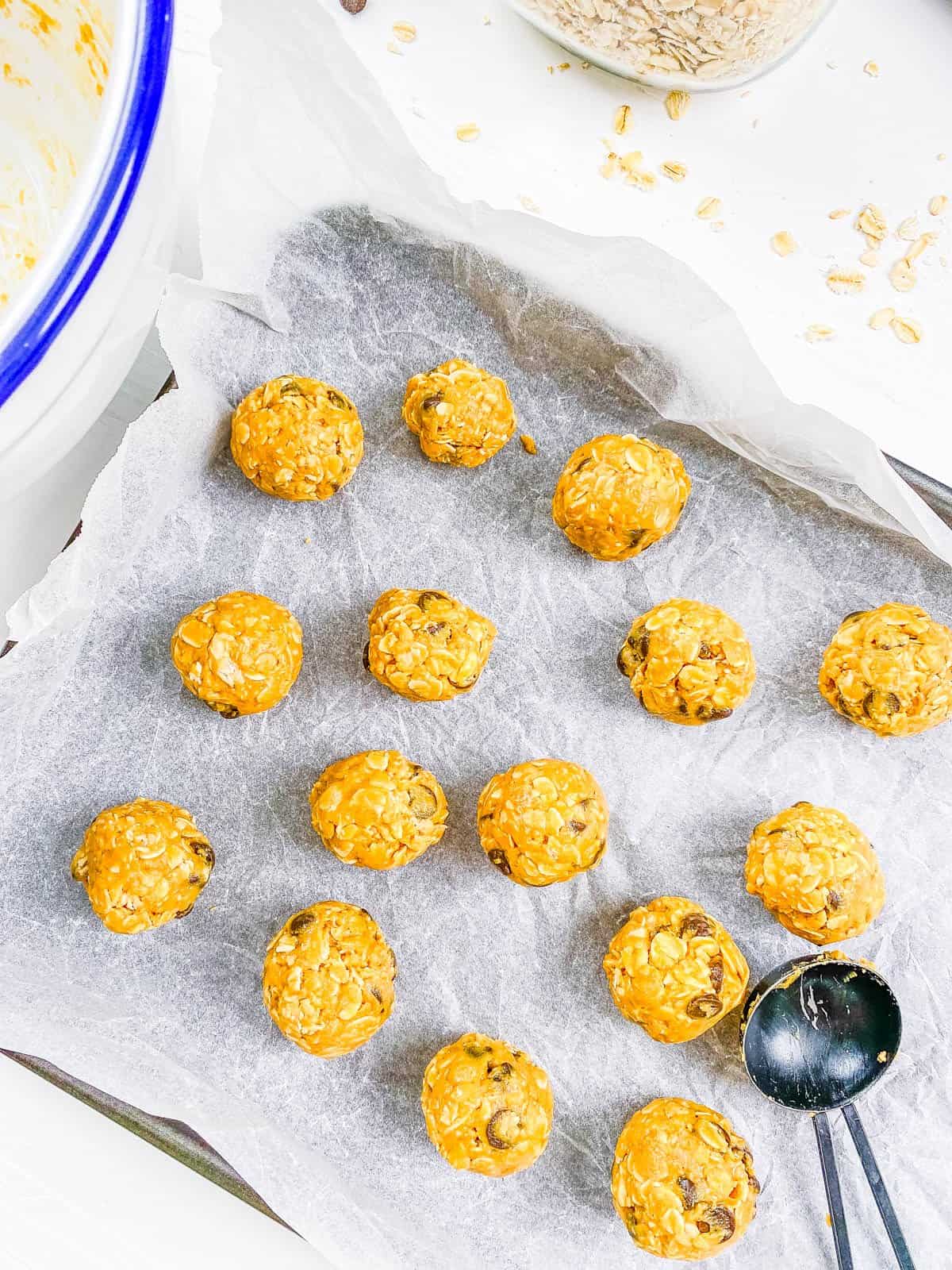
My #1 Secret Tip for this recipe is to make sure you measure ingredients precisely, with the right ratio of wet to dry ingredients.
While there is a little wiggle room with these bliss balls due to them being a no-bake recipe, I recommend being precise with all measurements to ensure ensures that the mixture has the right consistency to hold together without being too sticky or crumbly.
The creamy peanut butter is critical as the binding ingredient for these bliss balls, and I find it to be especially important to measure correctly. Too much or too little will throw the whole recipe off, leading to a mixture that is either too wet and sticky or too dry and crumbly.
After trial and error, I have found that achieving this balance is important for forming perfect bliss balls that stay intact and have a great texture.
Other Tips To Keep In Mind:
- Use The Right Tools: I like to use a cookie scoop to get all of these no-bake bliss balls the same size and to help my hands stay mess free!
- Check The Oats: If you or someone in your family is gluten intolerant, be sure to check the packaging on your oats for gluten-free certification. Some oats can be at risk for contamination with gluten substances.
- Involve The Kiddos: My kids love to help out in the kitchen, and this no-bake recipe is perfect for kids of all ages! They can learn how to measure out ingredients, combine ingredients, and roll the mixture into perfect ball shapes!
- Adjust For Moisture: If the dough seems too wet to mold into balls, consider adding a tablespoon or two of oat flour or almond flour. This will help to firm the mixture up so that it holds its shape and doesn’t stick to your hands.
- Bliss Balls For Kids: If you want to make these as toddler peanut butter balls I recommend reducing or omitting the sugar! You might also want to cut them into smaller bites when serving.
📖 Variations
I’ve perfected a few easy swaps and add-ins for when I’m looking to switch up the taste or texture a bit with these healthy kid-friendly bliss balls. There is something for any occasion! Here are my favorite variations:
Peanut Butter Protein Balls: If you want to turn these peanut butter protein bliss balls, consider adding a scoop of vegan vanilla protein powder to the batter before mixing it. You can use up to 2 scoops of protein powder, depending on the flavor of the protein powder you use. Sometimes I also add 1 tablespoon of ground chia seeds, flax seed, or hemp seeds for an extra boost of protein and healthy fats.
Chocolate Bliss Balls With Peanut Butter: For a double serving of chocolate, add a tablespoon of cacao or cocoa powder to the batter before mixing. I love the rich and indulgent flavor that this gives this recipe! I serve this as a healthy kids dessert often!
Peanut Butter Date Bliss Balls: For a sweeter flavor, I like to add a ¼ cup of Medjool dates, soaked and drained. I use a food processor when adding dates so that they are completely incorporated with the peanut butter and oats.
Sugar-Free Bliss Balls: If you want to make these no-bake peanut butter balls truly sugar-free, you can omit the maple syrup and use sugar-free chocolate. I think they still taste pretty good thanks to the natural sweetness from the vanilla and chocolate chips! If you are making these peanut butter balls for toddlers, this is a good option.
Mix-Ins: Add your favorite mix-ins to give these peanut butter energy balls some texture. I find that crushed walnuts, pecans, peanuts, sunflower seeds, and cacao nibs work really well in this recipe. My other favorites are dried fruit like cranberries, raisins, dried apricots, and shredded coconut. I also love adding spices like a pinch of sea salt, cinnamon powder, nutmeg, or pumpkin pie spice into the mixture. When making these as toddler protein balls, be mindful of the size of the nuts and dried fruit.
🍽 Serving Suggestions
While I love these healthy bliss balls with peanut butter on their own for an easy grab-and-go snack or healthy dessert, it can be so fun to get creative with other ways to serve these! Try some of these ideas:
Toppings: For a decadent dessert I love to drizzle chocolate sauce or caramel sauce (like the one on this no-bake salted caramel cheesecake) over these no bake snacks!
Ice Cream: My kids love to mix these no bake peanut butter dessert balls into tofu ice cream for a delicious treat.
Drinks: Energy balls can be found at a lot of coffee shops nowadays, so it only feels right to create those coffee shop vibes at home! I have been loving these balls with my oatmilk honey latte or iced ube latte! You can also do a creamy mixed berry smoothie alongside these protein balls for kids as an afternoon snack.
With Other Energy Bites: Make a spread of energy bites and serve these alongside my vegan protein balls, peanut butter date balls, and these homemade lara bars! I love this idea for parties and special occasions!
🫙 Storage Instructions
Room Temperature: I store these dairy free peanut butter balls in an airtight container at room temperature for up to 3 days.
To Refrigerate: After placing in an airtight container or resealable plastic bag, I’ll store these in the fridge for maximum freshness. They’ll be good for about one week!
Freezer: I don’t recommend storing these vegan energy balls in the freezer as they won’t taste as good when defrosted.
❓Recipe FAQs
The best type of peanut butter to use is natural peanut butter with no added sugars, oils, or preservatives. I recommend looking for a brand that has just one ingredient listed: peanuts. You can also use a brand that has peanuts and salt listed as the only two ingredients.
There are two ways I’d recommend adjusting this recipe if your mixture is too dry: 1) Add more peanut butter – it’ll help bind the ingredients and add moisture. 2) Add a little bit of coconut oil, maple syrup, or even a touch of applesauce – these ingredients will add moisture and flavor to your peanut butter oat balls!
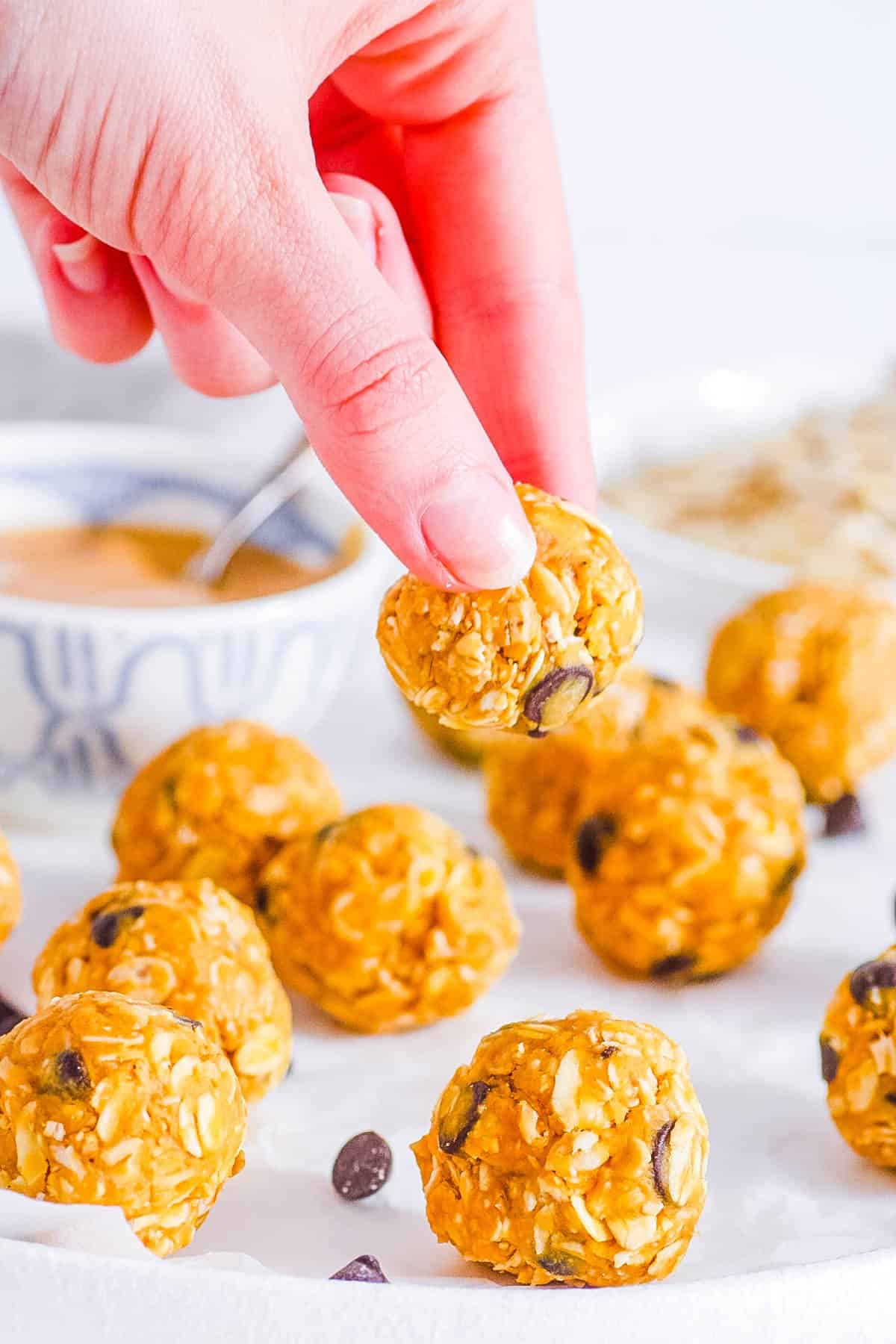
Want to Save This Recipe?
Enter your email & I’ll send it to your inbox. Plus, get great new recipes from me every week!
By submitting this form, you consent to receive emails from The Picky Eater.
Love this plant based dessert recipe? Please leave a 5-star rating 🌟 in the recipe below and/or a review in the comments section further down the page!
You can also FOLLOW ME on FACEBOOK, INSTAGRAM, and PINTEREST to see more delicious, healthy, family-friendly food, and if you have any questions, I’m here to help!
📋 Recipe Card
Healthy No-Bake Peanut Butter Bliss Balls
My healthy, easy no bake peanut butter bliss balls are loaded with creamy peanut butter and chocolate flavor, making them a hit with both kids and adults alike. Enjoy these as an on-the-go breakfast, wholesome snack, or healthy dessert alternative! They’re also dairy-free, vegan, gluten-free, and low in sugar, making them ideal for a variety of dietary preferences.
Servings: 16 balls
Calories: 93kcal
-
In a large bowl, using a wooden spoon, stir together the oats, peanut butter, chocolate chips, maple syrup, vanilla, salt (and protein powder, if using) until combined.
-
Line a baking sheet with parchment paper.
-
Taking small handfuls of the mixture, roll them into small balls 1-2 inches in size. Or you can use a cookie scoop. Place them onto the baking sheet.
-
Refrigerate the bites for 30 minutes or until solid. Store in an air-tight container in the fridge (they will last at least 1 week, and likely 2!)
- Use The Right Tools: Use a cookie scoop to get all of the balls the same size.
- Check The Oats: If you or someone in your family is gluten intolerant, be sure to use gluten-free oats.
- Involve The Kiddos: This is such a great no bake recipe for kids to make – get them in the kitchen!
- Adjust For Moisture: If the dough seems too wet to mold into balls, consider adding a tablespoon or two of almond flour.
- Sugar Free: If you want to make these truly sugar-free, you can omit the maple syrup, and they will still taste pretty good.
- Peanut-Free: Use your favorite alternative nut butter or seed-based butter.
- Nutritional information includes protein powder. Note: for even more protein, use 1 scoop of vegan vanilla protein powder and 1 scoop of peanut butter protein powder.
Serving: 1ball | Calories: 93kcal | Carbohydrates: 8g | Protein: 4g | Fat: 5g | Saturated Fat: 2g | Polyunsaturated Fat: 1g | Monounsaturated Fat: 2g | Cholesterol: 4mg | Sodium: 43mg | Potassium: 92mg | Fiber: 1g | Sugar: 3g
Health
Federal Experts Talk Bird Flu ‘What Ifs’ in WebMD Live Event

May 16, 2024 – Multiple U.S. agencies are working to contain the recent bird flu outbreak among cattle to prevent further spread to humans (beyond one case reported in early April) and use what we learned before, during, and after the COVID-19 pandemic to keep farm workers and the general public safe.
Fingers crossed, the bird flu will be contained and peter out. Or the outbreak could continue to spread among dairy cattle and other animals, threatening the health and livelihoods of farmers and others who work with livestock.
Or the virus could change in a way that makes it easier to infect and spread among people. If this happens, the worst-case scenario could be a new influenza pandemic.
With so many unknowns, WebMD brought together experts from four federal agencies to talk prevention, monitoring, and what the “what ifs” of bird flu might look like.
Communication with the public “about what we know, what we don’t know, and ways you and your family can stay safe is a priority for us at CDC,” said Nirav D. Shah, MD, JD, the CDC’s principal deputy director. “We at the federal level are responding, and we want the public to be following along.”
People should consult the websites for the CDC, FDA, U.S. Department of Agriculture (USDA), and the Administration for Strategic Preparedness and Response (ASPR) for updates.
It is essential to not only stay informed, but to seek trusted sources of information, Shah said during “Bird Flu 2024 – What You Need to Know,” an online briefing jointly sponsored by the CDC and WebMD.
An ‘Experimental Hamburger’
If one take-home message emerged from the event, it was that the threat to the general public remains low.
The retail milk supply is safe, although consuming raw or unpasteurized milk is not recommended. “While commercial milk supply is safe, we strongly advise against drinking raw milk,” said Donald A. Prater, DVM, acting director for the FDA’s Center for Food Safety and Applied Nutrition.
As for other foods, thoroughly cooked eggs are less risky than raw eggs, and the nation’s beef supply remains free of the virus as well.
For years, federal inspectors have purchased and tested meat at retail stores, said Eric Deeble, DVM, USDA deputy assistant secretary for the Office of Congressional Relations. So far, H5N1, the virus behind bird flu, has not been detected in beef.
The USDA took testing a step further and recently cooked ground beef from dairy cows in their lab. Using what Deeble described as an “experimental hamburger,” the agency showed cooking beef to 165 F or higher kills the virus if it ever becomes necessary.
The federal government now requires all cattle be tested and be free of bird flu virus before crossing any state lines. The government is also reimbursing farmers for veterinary care and loss of business related to the outbreak, and supply personal protective equipment (PPE) like gloves, masks, and face shields to workers.
Vaccination Not Recommended Now
Federal scientists know enough about H5N1 virus to create vaccines against it quickly if the need arises. It’s more about planning ahead at this point. “Vaccines are not part of our response right now,” said David Boucher, PhD, director of infectious diseases preparedness and response at the Administration for Strategic Preparedness and Response.
If the virus changes and becomes a bigger threat to people, “we have the building blocks to produce a vaccine,” Boucher added.
An event attendee asked if the seasonal flu shot offers any protection. “Unfortunately, the flu shot you got last year does not provide great protection from the avian flu,” Shah responded. “It might do a little bit … but that is the vaccine for seasonal flu. This is something more novel.”
Treatments Stockpiled and Ready
Antiviral medications, which if given early in the course of bird flu infection could shorten the severity or duration of illness, are available now, Shah said. The dairy farmer who was infected with bird flu earlier this year responded to oseltamivir (Tamiflu) treatment, for example.
When it comes to bird flu symptoms, the fact that the only infected person reported so far this year developed pink eye, also known as conjunctivitis, is interesting, Shah said. Officials would have expected to see more typical seasonal flu symptoms, he added.
“Influenza is not a new virus,” Boucher said. “With this strain of influenza, we are not seeing any genetic markers associated with resistance to antivirals. That means the antivirals we take for seasonal influenza would also be available if needed to treat H5N1.”
ASPR has stockpiled Tamiflu and three other antivirals. “We do have tens of millions of courses that can be distributed around the country if we need them,” he added.
“Influenza is an enemy we know well,” Boucher said. That is why “we have antivirals ready to go now and many types of PPE.”
Science in Action
The feds intend to stay on the case. They will continue to monitor emergency department visits, lab test orders, and wastewater samples for any changes suggesting a human pandemic risk is growing.
“While we’ve learned a great deal, there are still many things we do not know,” Deeble said.
Shah added, “As in any outbreak, this is an evolving situation and things can change. What you are seeing now is science in action.”
For the latest updates on bird flu in the United States, visit the CDC’s H5N1 Bird Flu: Current Situation Summary website.
-

 African History4 months ago
African History4 months agoBlack History Facts I had to Learn on My Own pt.6 📜
-

 African History4 years ago
African History4 years agoA Closer Look: Afro-Mexicans 🇲🇽
-

 African History1 year ago
African History1 year agoPROOF AFRICAN AMERICANS AIN'T FROM AFRICA DOCUMENTED EVIDENCE
-

 African History2 years ago
African History2 years agoHow Did Normal Medieval People Survive Winter? | Tudor Monastery Farm | Chronicle
-

 African History4 years ago
African History4 years agoA Closer Look: Afro-Mexicans 🇲🇽
-

 African History3 years ago
African History3 years agoThe Entire History of Africa in Under 10 Minutes – Documentary
-

 African History3 years ago
African History3 years agoWhat happened to the many African Kingdoms? History of Africa 1500-1800 Documentary 1/6
-

 African History2 years ago
African History2 years agoAFRO MEXICO: Black History In Mexico!

